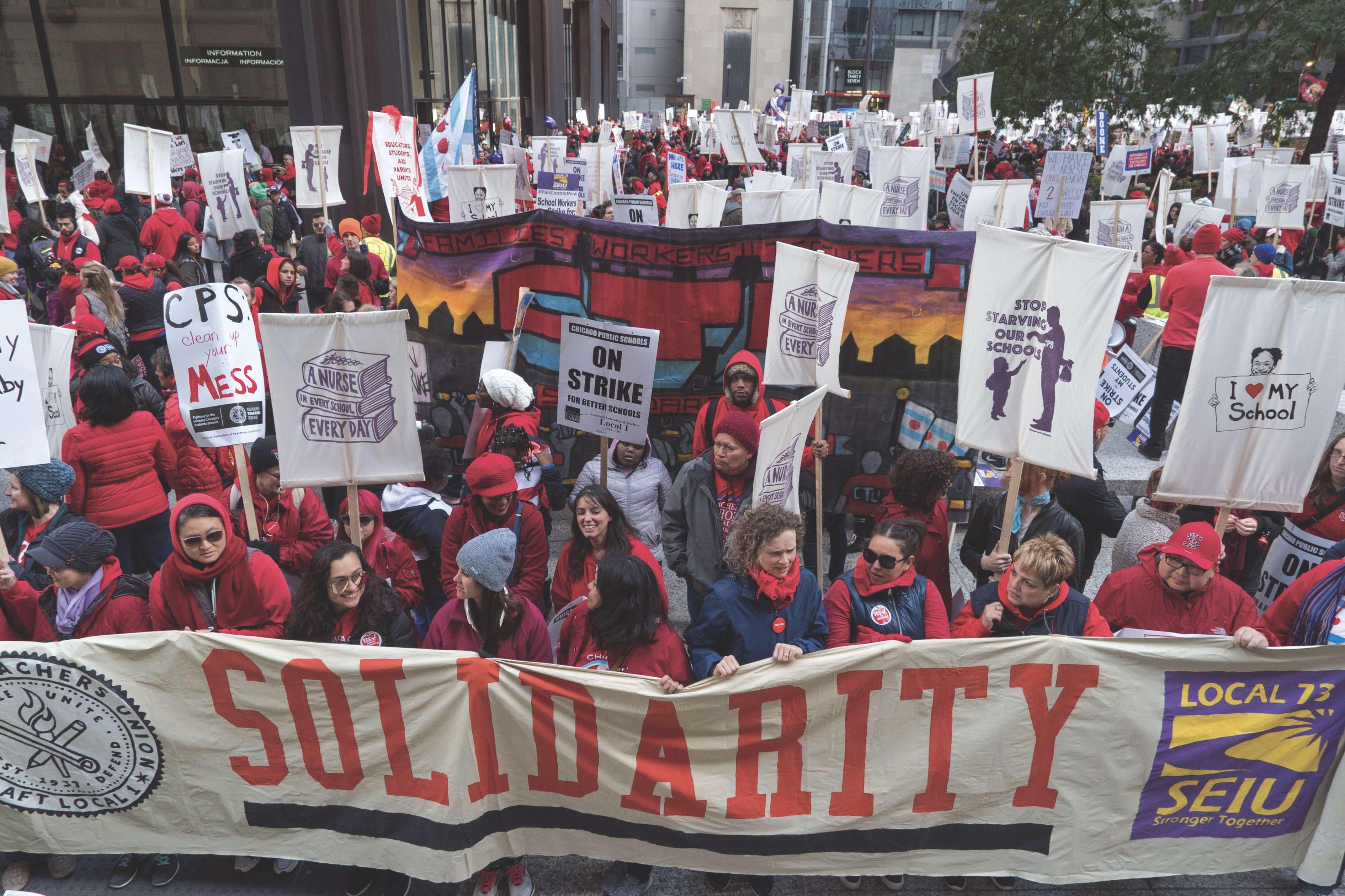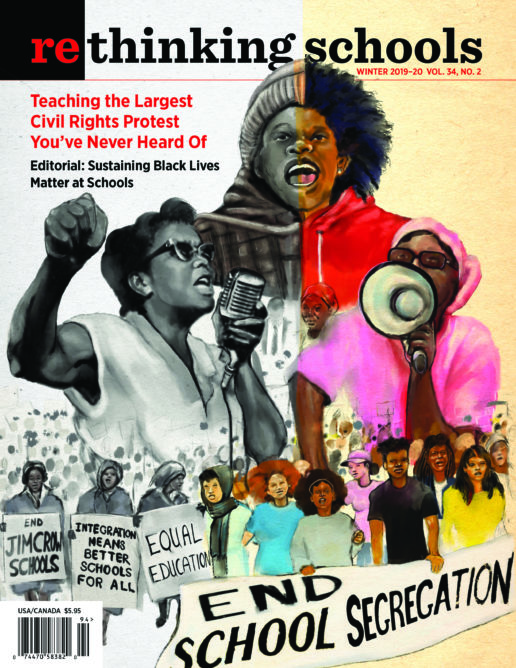Red for Ed: The Movement Strengthens and Continues
Illustrator: Joe Brusky

In 2018, numerous commentators portrayed the West Virginia, Oklahoma, Arizona, and Kentucky school walkouts as a purely “red state” phenomenon. But events this year have made clear that the strike wave is national in scope and shows no signs of ebbing anytime soon.
For supporters of public education, the big story of 2019 is that the Red for Ed movement has continued to spread. The strikes have empowered hundreds of thousands of teachers and students, reinvigorated unions, and dramatically shifted the public narrative around the crisis facing public education.
Blaming educators has begun to give way to blaming school underfunding — a political sea change that should not be underestimated. The ousting of anti-teacher Republican governor Matt Bevin in the November election in Kentucky illustrates what happens these days to politicians who demonize educators. And with wind in their sails, unions are increasingly pointing their fingers at the billionaires responsible for the crises confronting our schools. Chicago Teachers Union Vice President Stacy Davis Gates put it well: “Where will the money [to fund public education] come from? Rich people.”
Of this year’s work stoppages, the most important have certainly been January’s Los Angeles strike and October’s strike in Chicago. Each were offensive actions to reverse the austerity regimes imposed by corporate Democrats over the past two decades; each foregrounded the fight for “common good” demands such as increased nurses and counselors, as well as smaller class sizes; and each highlighted the interconnection between the fight for public education and the fight for racial justice.
One particularly significant new development was that Chicago’s strike — like the 2018 West Virginia walkout — was not only of teachers, but also school workers. Thousands of special education classroom assistants, custodians, bus aides, and security guards organized into SEIU Local 73 walked the picket lines to fight for living wages and better working conditions. The result was a significantly stronger work stoppage, one that made clear to the public that it takes more than teachers to make a school run.
Another one of the big stories of 2019 is that Red for Ed’s center of gravity has shifted to “blue” cities and states led by corporate Democrats. In Oakland, February’s walkout had a similar social justice orientation to Chicago and Los Angeles, though with only six months to prepare its campaign, the union’s contract wins fell somewhat short of the gains won by the predecessors. And the strike wave finally reached the East Coast on Oct. 25 when educators in Dedham, Massachusetts, walked out — an illegal strike that consciously challenged the state’s ban on public sector strikes. Though it took place in a small district, Dedham’s victory was important because it again showed that strike bans are surmountable and because it has the potential to inspire similar actions across Massachusetts.
So-called “red states” have also seen some important work stoppages this year. In February, West Virginia educators organized another successful statewide strike, this time to stop the introduction of charter schools. Nashville, Tennessee, educators organized wildcat sickouts in May. On Nov. 14, educators in Little Rock, Arkansas, organized a one-day strike to stop racial resegregation and to demand democratic local control of their school district. And Indiana teachers followed suit on Nov. 19, in a statewide walkout to demand more funding, better pay, and an end to over-testing.
Whereas most of the aforementioned work stoppages raised social justice issues and were led either by militant union leaders or unruly rank-and-filers, one of the less reported developments of 2019 has been the spread of strikes narrowly focused on wages and led by relatively moderate union officials. Examples of such actions include the February 2019 strike in Denver, the May-June strike in California’s New Haven school district, and the November walkout in West Sonoma, California, as well as numerous walkouts in smaller school districts across the country. Though the results of these work stoppages have been mixed, it’s a sign of the times that even old-school union leaderships have felt the pressure to take action.
Tensions between a deepening educator upsurge and risk-averse union leaderships have led to the growth and spread of rank-and-file caucuses across the country. Many of these, including the new West Virginia United Caucus, have coalesced around UCORE, the United Caucuses of Rank-and-File Educators.
Hoping to replicate the democratic organizing methods, social justice focus, and militant actions promoted by fight-back leaderships in Chicago, Los Angeles, and beyond, educators have recently elected rank-and-file reformers to union leadership in Denver, Baltimore, and Nashville. And in Philadelphia, the Caucus of Working Educators has a good chance at winning in the early 2020 union elections. The emergence of these new leaderships illustrates the depth of teacher dissatisfaction with the status quo and it promises to sustain the educators’ upsurge over the years to come.
It would be a mistake, however, to overlook the defeats experienced by, and the challenges that continue to face, the Red for Ed movement. In 2018, the powers that be were somewhat caught off guard by the walkouts; this year they are clearly much better prepared. In June, the West Virginia Legislature took advantage of the end of the school year to ram through the same charter legislation that striking educators had defeated just a few months earlier. Arizona’s movement still has not recovered from the blow delivered by the right-wing state Supreme Court’s decision to unilaterally remove its progressive funding initiative from the ballot. And in New Haven, California, educators returned to school after 14 days of striking without wresting any major concessions from the district.
Even in cities and states with more successful strikes, the outcomes have nevertheless tended to fall short of the type of deep transformation desired by most teachers. In large part, this reflects a positive development: Participating in these actions has dramatically raised educators’ expectations. Yet there is also only so much that one walkout — particularly when limited to a single district — can do to turn around decades of public school neglect. The work stoppages in Los Angeles and Chicago, despite their unquestionable power, were not able to win all the demands raised by unionized educators.
One crucial step toward generating increased political leverage would be to spread the strike upsurge to other sectors of the economy. There is only so far that educators can go in the absence of a broader revitalization of organized labor. As the rank-and-file outpouring in the recent month-long United Auto Workers strike attests, large numbers of workers across the country are ready to fight. But in the face of such powerful opponents, turning that potential into a reality is much easier said than done, particularly in the private sector.
The mixed results of this year’s actions also underscore that strikes, while necessary for the revival of labor and the transformation of public education, are not sufficient on their own to win the funding necessary for the schools that our students deserve. Without political solutions like ballot initiatives to tax the rich and without electing working-class fighters to office, it’s hard to imagine how Red for Ed will be able to ultimately reach its ambitious goals.
Effectively combining mass action with independent electoral interventions is no easy task, but United Teachers Los Angeles (UTLA) is providing some indications on how this can be done. UTLA has helped spearhead a statewide coalition to pass an ambitious progressive taxation initiative in California’s November 2020 elections that would raise $13 billion for schools and public services by reforming Proposition 13. Fully funding our schools will likely require similar initiatives across the country.
UTLA has also pushed the envelope for the 2020 presidential elections when it endorsed Bernie Sanders on Nov. 14. Though most Democratic candidates are currently saying good things about public education, UTLA argued that Sanders’ ambitious Thurgood Marshall Plan for Public Education and his consistent social movement-building orientation set him apart from the pack. In an important step toward union democracy, the American Federation of Teachers national leadership announced the following day that it was giving its locals the green light to issue their own primary endorsements. Internal union debates will likely be vigorous over the coming months, particularly since Elizabeth Warren has issued an education plan that rivals Sanders’ in its commitment to reversing the corporate education reform agenda.
A final point: Red for Ed activists cannot ignore the challenge and opening posed by climate change. An essential task for education activists over the coming months and years will be to find ways to link up with student-led actions like the climate strike and to make the case that fighting for great public schools is a climate fight. Not only is teaching a green job, it’s a profession that needs to be fully funded to train a new generation to be able to build a sustainable, and egalitarian, society. Given the stakes of averting climate catastrophe, Red and Green for Ed may be the future of the movement.

